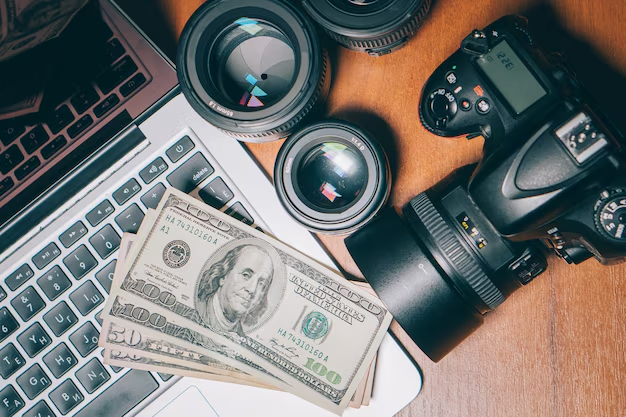Photography’s ubiquity might suggest a diminished value as a collectible, but its widespread acceptance, coupled with deliberate artificial scarcity and the physical presence of works, has attracted new collectors. While art was historically for the wealthy, market data now shows growth in lower and middle-price segments, indicating a broadening collector base. Photography, with its accessibility, acts as an attractive “entry market” into the art world. This article explores market dynamics, collector trends, and strategies for photographers to enhance their work’s value.
Market Analysis: Shifting Dynamics and Opportunities
The global art market is recalibrating amid economic uncertainties. In 2024, total sales decreased by 12% to $57.5 billion, but transaction volume increased by 3% to 40.5 million sales, indicating a shift towards more affordable art. The high-price segment (over $10 million) saw significant declines, while sales under $5,000 grew in both value (7%) and volume (13%). This suggests a broader, more diversified sales base.
The United States maintained its lead with 43% of global sales, despite a 9% revenue decrease. The UK regained second place (18%), and China fell to third (15%). Smaller galleries (under $250,000 turnover) showed resilience with a 17% sales increase, contrasting with a 9% decline for top-grossing galleries (over $10 million turnover). This hints at a strengthening primary market, particularly for emerging artists. Private sales increased at Christie’s (41%) and Sotheby’s (17%), reflecting a desire for discretion.
The auction market for photography is modest compared to paintings. From 2005 to 2024, total photography sales were $3.07 billion. While inflation-adjusted average prices per lot decreased by 52.7% (from $16,068 in 2005 to $7,608 in 2024), record sales still occurred, such as Man Ray’s Le Violon d’Ingres for $12.4 million in 2022. The most active price range for photography is under $5,000, with a 36% increase in sales value since 2022.
The overall market contraction coupled with increased transaction volume and growth in lower price segments signals market democratization. Photography, with its lower entry prices, is well-positioned for this. Increased activity in accessible segments points to a broader collector base. The resilience of smaller galleries, especially for emerging artists, suggests collectors are investing in new talent or that smaller galleries are more agile. While auction results for photography show declining average prices, significant dynamism exists below the high-sales auction houses, particularly in the under-$5,000 segment, highlighting the importance of the primary market and affordable online segments.

Collector Trends: Values, Digital Savvy, and Inclusivity
The evolving art collector landscape is driven by a new generation seeking deeper meaning beyond aesthetics. Collectors increasingly value art reflecting cultural identity, environmental consciousness, and social impact. Purchasing decisions align with personal and societal values, with sustainability and ethical production gaining importance.
Millennials and Generation Z are digitally savvy, using online platforms for art purchases; 76% buy art digitally. They prefer direct artist interactions and transparent processes, often bypassing traditional galleries. Their decisions are less driven by investment and more by personal connection and authenticity. Despite digital preference, Gen Z values physical prints, indicating a hybrid preference. Dealers reported that 44% of their 2024 buyers were new customers, emphasizing increased market accessibility. Women are also increasingly buying and selling art, aligning with new interests. The representation of female artists in galleries rose to 41% in 2024, indicating a more inclusive market.
This shift towards values-driven collecting means that for photographers, the message, context, and sustainability of materials and processes are crucial. This signifies a move from purely speculative purchases to a deeper, personal connection to art. Photographers must build a strong online presence and ensure high-quality physical prints, presented through virtual galleries or Augmented Reality (AR) tools, to reach this new generation.
Gallery Strategies and the Primary Market
Galleries remain central to the art market, adapting by integrating online viewing rooms and sales functions. Over a third of international galleries’ sales in 2020 were online. Gallery representation offers increased visibility, audience reach, credibility, and professional support. Challenges include typical 50% commissions and potential cost-passing for art fairs. Platforms like Artsy often require gallery representation, highlighting their role as gatekeepers and quality filters. A gallery’s digital presence indirectly increases the value of represented photographic artworks. Photographers must actively collaborate with their galleries, ensuring their interests are represented.
The Role of Editions, Signatures, and Certifications
In fine art photography, editioning, signing, and certification are fundamental for value creation. Limited editions (typically 500 or fewer) create scarcity and exclusivity. Smaller editions lead to higher value per piece. Artist’s Proofs (AP), a subcategory (10-15% of an edition), are highly desirable due to rarity and a premium price.
A Certificate of Authenticity (COA) is essential for limited editions, confirming legitimacy, originality, and provenance. It includes artist and artwork details, edition information (e.g., “1/25”), artist’s signature, and printing process details. Security features like holograms or watermarks enhance security, and registration in a central provenance database increases value.
Photography’s reproducibility necessitates artificial scarcity through limited editions and APs to create investment value and elevate it to “Fine Art.” The COA acts as a “digital twin” of the artwork, guaranteeing originality and provenance, which is crucial in an era of digital manipulation. A robust COA minimizes risk and creates transparency for collectors.

Digital Horizons: NFTs and Future Provenance
Digital transformation increasingly impacts the art market through NFTs, AI, and AR. NFTs are unique digital assets with blockchain-verified authenticity, provenance, and ownership. Artists can earn royalties from secondary sales, creating a sustainable income model. The online fine art market is projected to grow to $35.34 billion by 2034. Online channels accounted for 18% of global art sales in 2024.
AI is seen as an innovative tool, producing new image forms and challenging notions of truth in photography. AR allows collectors to visualize artworks in their environment, and virtual galleries overcome geographical barriers.
Traditional COAs secure provenance for physical works, while NFTs extend this to digital art, offering immutable, blockchain-based provenance and enabling artists to earn secondary sale royalties. This addresses art investment liquidity concerns. AI is not just an editing trend but an artistic partner, creating conceptual depth and new niches.
Successful Photographers: Case Studies as Assets (as of July 2025)
The value of photographic artwork is tied to the artist’s reputation. Established “blue chips” include:
- Cindy Sherman: $160.3 million in auction sales over two decades, with a set of “Untitled Film Stills” fetching $6.8 million in 2014. Her market increased in 2021 after joining Hauser & Wirth.
- Andreas Gursky: $139.8 million in sales. Rhein II (1999) sold for $4.3 million in 2011, then the most expensive photograph auctioned. 32 of his photos sold for over $1 million.
- Ansel Adams: $88.4 million in total sales, with consistent high sales without individual peaks, though none of his prints have exceeded $1 million.
The most expensive photographs are Man Ray’s Le Violon d’Ingres (1924) at $12.4 million (2022) and Edward Steichen’s Flatiron (1904) at $11.8 million (2022).
Artist reputation, limited editions, subject matter, and condition influence value. There’s growing interest in contemporary fine art photography and emerging artists. Sherman’s market increase after joining a major gallery highlights the link between professional representation and value appreciation. While record prices exist, photography’s dynamism lies in the affordable segment (under $5,000), which is growing significantly. This democratization creates opportunities for emerging artists.
Practical Strategies for Photographers: From Motif to Value Enhancement
For photographers aiming to establish their works as a sustainable asset, strategic decisions and market understanding are essential.

Artistic Excellence and Conceptual Depth
Artistic quality and uniqueness are the cornerstones of value. Develop a distinctive signature and coherent series. Authenticity and a personal perspective are paramount. Experiment with digital manipulation, new lenses, vintage equipment, or mixed media. Works should have a clear, captivating narrative. The quality of the final print and presentation is crucial. Invest in high-quality museum-grade prints, professional framing, and finishing. A professional portfolio and showcasing art in context (e.g., mock-ups) are essential. Unique perspective and coherent series define an artist’s value. Collectors seek emotional or intellectual connection, arising from the artist’s distinctive voice. The transformation of a digital file into a “Fine Art Print” requires expertise beyond just the capture. Professional presentation justifies higher prices and signals seriousness.
Editioning and Authenticity: The Foundation of Value
Controlled scarcity and seamless documentation are fundamental. Deliberately set small edition sizes (e.g., 5, 10, or 50) for greater exclusivity and higher prices. An edition of 500 or fewer is typical. Consider offering different sizes in different editions. Each limited artwork should be personally signed and numbered. Offer a small number of Artist’s Proofs (AP), typically 10-15% of the edition, as they are highly sought after and can be sold at a higher price. Issue a detailed Certificate of Authenticity (COA) for each limited edition, including artist and artwork details, edition information, artist’s original signature, and printing process details. Security features like holograms and registration in a central provenance database enhance security and value. This tiered pricing allows photographers to appeal to a wider range of collectors while maximizing the value of rarer pieces. The COA becomes a beacon of trust, proving authenticity and commitment to limitations, essential for long-term value development and resaleability.
Strategic Presence: Galleries, Online Platforms, and Own Channels
A diversified approach maximizes visibility and reaches various collector segments.
- Gallery Representation: Research galleries matching your style. Personal introductions are often best. Advantages include access to an established collector base, marketing, credibility, and exhibition opportunities, potentially leading to higher prices. Be aware of the usual 50% commission.
- Online Platforms: Saatchi Art allows artists to set prices (40% commission). Artsy works only with galleries, underscoring the need for gallery representation to access this platform.
- Own Online Shops: Offer full control over pricing and brand image, and higher profit margins. Best practices: professional website with “Art Gallery Website” functionality, high-resolution images, and detailed descriptions.
- Art Fairs and Auctions: Art fairs remain a key source for new buyers and offer personal interactions. Auction houses (Sotheby’s, Christie’s) are important for high-priced works, but the photography auction market is modest.
No single distribution channel is sufficient. An omnichannel strategy combining physical galleries, major online platforms, and direct sales is crucial. This allows photographers to reach different collector segments and pursue various pricing strategies. Consistency across all channels is crucial for credibility. Artsy acts as an influential gatekeeper, making gallery representation essential for top online platform presence.
Marketing and Visibility in the Digital Age
Effective marketing is crucial for standing out. A professional website and active social media profiles (Instagram, Pinterest) are essential. Share high-quality images and videos, including behind-the-scenes glimpses. Tell the story behind your works. Build an email list for targeted campaigns. A blog can strengthen your authority. Optimize your website with SEO. Show your art in situ using mock-ups. Network with artists, collectors, curators, and gallerists. Utilize new technologies like AI tools for workflow optimization and AR for immersive experiences, and NFTs as digital certificates or standalone digital artworks with royalty potential. Photographers must become their own brand managers, building a coherent online presence and actively using social media and email marketing to tell a story and build direct collector relationships. Strong personal branding builds trust and recognition. Showing artworks in a “setting” helps potential buyers visualize the work, influencing perceived value and willingness to buy.
Looking Through the Lens of Time
Fine art photography is a fascinating and increasingly lucrative segment of the global art market. Its resilience, particularly in accessible price segments and through digital innovations, is notable. Market data shows a shift towards more affordable works and increased transaction volume. The democratization of the market, coupled with digitally savvy collector generations, opens new horizons. Photography is uniquely positioned to bridge traditional art forms and the emerging digital art world, existing as both a physical print and a digital object via NFTs. This hybrid nature attracts an evolving collector base valuing both physical ownership and digital innovation.
The future of photographic art as an investment will be shaped by the convergence of traditional values and technological advancements. Authenticity, provenance, and controlled scarcity will be enhanced by digital certifications and blockchain. Younger collectors will increasingly act in a values-driven manner, demanding a transparent, accessible, and digitally integrated art world. The trend towards “ecological and nature-inspired art” and “sustainability” will become important value drivers. For photographers, this means considering sustainable materials and processes.
For photographers, the path from motif to asset requires conscious strategic planning: cultivating a unique artistic vision, meticulous editioning and certification, a diversified market presence through galleries and online channels, and proactive digital marketing. The ability to adapt to and creatively use new technologies like AI and AR will be crucial. Investing in fine art photography is a long-term perspective encompassing financial considerations and a deep appreciation for the art itself, offering the unique opportunity to acquire cultural richness while participating in a dynamic and changing market.









